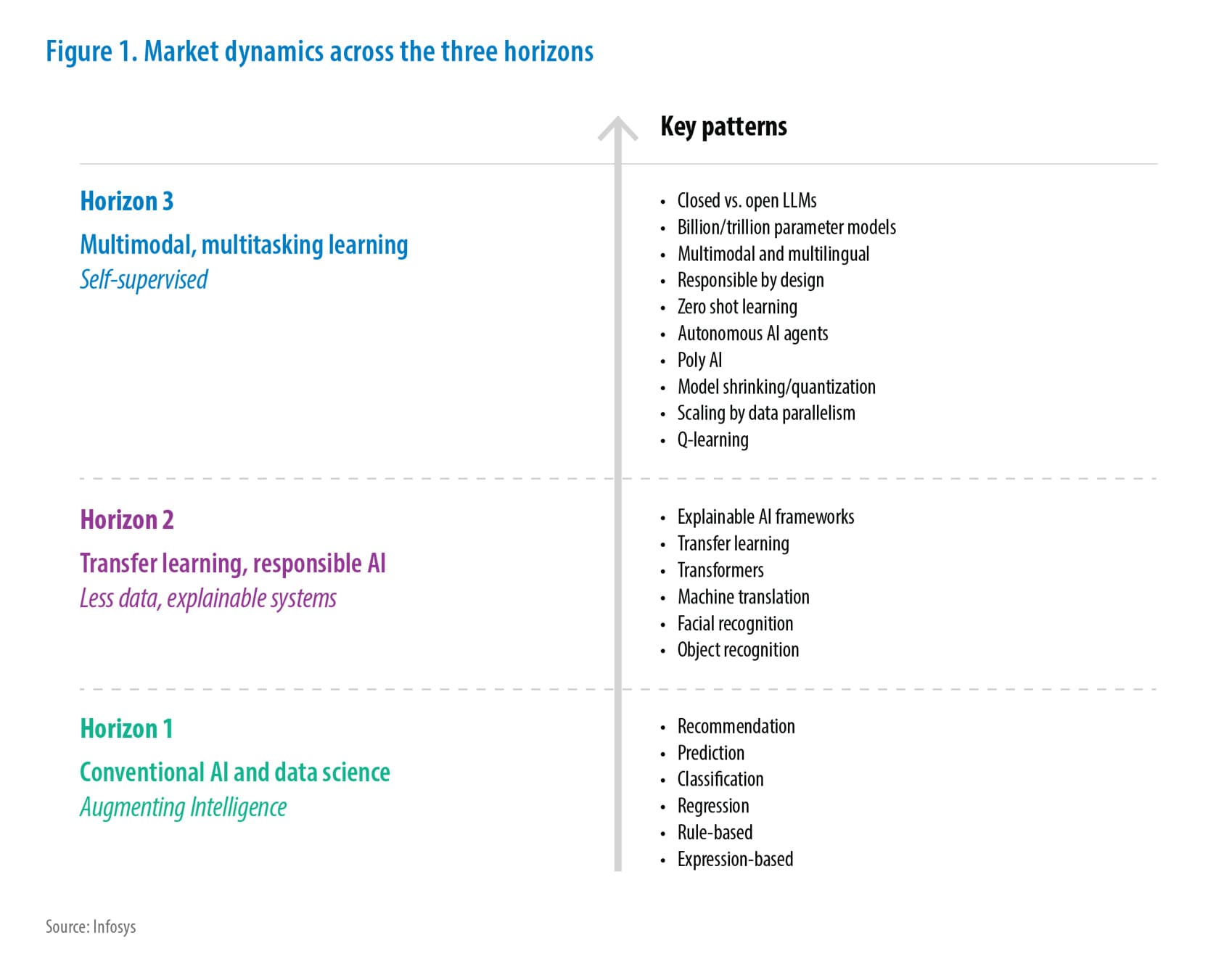Artificial Intelligence
Artificial intelligence powers forward through groundbreaking advances in machine learning, predictive analytics, deep learning, and the game-changing transformer architecture. The expanding influence of generative AI signals a seismic shift. Businesses break free from traditional AI roles and reimagine customer experiences and service delivery. The future is not just intelligent, it's creatively unpredictable.
H3
Multimodal, multitasking learning
Self-supervised
Key Patterns
- Closed vs. open LLMs
- Billion/trillion parameter models
- Multimodal and multilingual
- Responsible by design
- Zero shot learning
- Autonomous AI agents
- Poly AI
- Model shrinking/quantization
- Scaling by data parallelism
- Q-learning
H2
Transfer learning, responsible AI
Less data, explainable systems
H1
Conventional AI and data science
Augmenting Intelligence
Key trends across AI subdomains
Trend 1
Closed-source foundational models gain wider acceptance
Closed-source large foundational models like GPT-3.5/4/Turbo, Anthropic, PaLM, and Claude thrive on minimum infrastructure, which boosts their use cases across diverse segments. Enterprises can use closed models for industry use cases even without fine tuning, aided by retrieval augmented methods (which improves AI trust and quality), such as semantic search.
Trend 2
Organizations leverage LLMs for seamless code migration
LLMs like GPT-4, trained in diverse codes and programming languages, excel in contextual inference, pattern recognition, and generalization. They interpret legacy languages and generate code in modern languages, facilitating migration from languages like assembly, Smalltalk, and C/C++.
Trend 3
LLMs optimize knowledge management and semantic search
Transformer models, incorporating embedding generation like OpenAI's GPT-3.5 and Microsoft's E5 Large, precisely navigate industry contexts. Embeddings capture data's principal components, forming low-dimensional vectors that faithfully represent the original data.
Trend 4
LLMs improve productivity across the software development life cycle
Companies increasingly explore LLMs to improve overall productivity across the software development life cycle, customizing user experiences through fine-tuned generative AI models. As our Tech Navigator: Building the AI-first organization discusses, data scientists are encouraged to use their preferred tools, combining open and closed AI models based on the enterprise use case.
Trend 5
Autonomous agents shape the future of generative AI
AI agents are autonomous workers who independently execute tasks aligned with predefined goals and parameters. They are behind-the-scenes workhorses, independently accomplishing tasks — a contrast to tools like Copilot, which primarily serve to aid and guide.
Trend 6
Generative multimodal models become popular
Initially, NLP focused on bag-of-words representation, emphasizing individual words with hot encoding-based sparse vectors. Then came models like GloVe and Word2Vec that addressed word similarity, but lacked contextual information, leading to biases.
Trend 7
Instruction-tuned LLM multitasking facilitates fluid and natural conversations
LLMs, trained without specific labels and through reinforcement learning, effortlessly grasp insights from extensive text, smoothly adapting to new tasks and scenarios for enhanced flexibility.
Trend 8
Language-neutral audio processing breaks language barriers
Audio communication grappled with language barriers initially. Language-neutral audio processing aims to surpass spoken language limitations, making audio a universally understood exchange of information and emotion.
Trend 9
Hyper-realistic speech generation and multimodal fusion transform AI experiences
From robotic mimics to hyper-realistic speech generation (HRSG) — a breakthrough that infuses voices with life, producing near-perfect replicas rich in emotion, nuance, and individuality. Personalized voice cloning replicates voice with uncanny accuracy, making use cases for narrating audiobooks, guiding AI assistants, and creating virtual avatars that speak specific words.
Trend 10
Compact multimodal intelligence revolutionizes industries
Retail, logistics, healthcare, and manufacturing currently harness pretrained foundation models for computer vision tasks such as image classification, object detection, and segmentation. While these models offer rapid customization, they are large and often require substantial data for fine tuning.
Trend 11
Key point detection elevates retail experience
Key point detection identifies and localizes specific points of interest in an image, including body pose, to analyze ongoing human behavior. This form of computer vision can be used by businesses to analyze interactions with products and provide actionable insights for improved customer engagement.
Trend 12
Edge AI enhances efficiency and power across industries
Edge AI transforms AI deployment by prioritizing on-device processing, reducing reliance on central servers for instant decisions. This optimization significantly improves latency, response times, security, and bandwidth efficiency — crucial in applications like autonomous vehicles. Edge computing also minimizes data transmission, enhancing privacy in computer vision.
Trend 13
Generative AI shapes the future of edge
The next development in edge computing is generative AI use cases. Earlier LLMs like GPT-3.5 or GPT-4 were too big for edge deployment. To optimize Edge AI will process inputs from multiple modalities (vision, audio, text) and emerge as a transformative force in our interconnected world. This imminent progression promises heightened potency on the edge, paving the way for more efficient and powerful edge AI models across diverse industries.
Trend 14
Enterprise AI and decision making intensify with synthetic data
Enterprise AI intensifies the reliance on data for decision-making, but finding suitable training data remains a challenge. Enter synthetic data — computer-generated, algorithmically crafted datasets filling gaps where real data is scarce, sensitive, biased, or poses privacy risks. It powers generative AI, robotics, metaverse, and 5G, extending into mission-critical scenarios like healthcare.
Trend 15
Industrialized AI enhances data scientists' experience
Data scientists, traditionally involved in manual data analysis and cleansing, lack standardized tools for wrangling, analytics, feature engineering, and model experimentation. The shift toward an industrialized ecosystem sees increased adoption of automated advisory for faster feature engineering and improved quality analysis.
Trend 16
AI security emerges as the bedrock of enterprise resilience
Responsible AI concepts should be factored in from the beginning to ensure the business stays out of any AI ethics and bias issues. Explainability is one such critical concept. The design and development teams should be aware and informed of every step in the AI lifecycle to answer any related questions, providing all information AI users would seek to understand how and why the system made a decision.
Trend 17
Responsible AI guardrails uphold ethical AI
Responsible AI guardrails encompass a set of rules and best practices designed to ensure the ethical and responsible development, deployment, and utilization of AI systems. These guidelines address ethical, legal, and societal concerns associated with AI, aiming to mitigate potential risks and harms. The relationship between AI and responsible AI guardrails is dynamic, with AI influencing and being influenced by advancements in technical guardrails and ethical guidelines.
Trend 18
AI democratization unlocks business potential
Over two-fifths of APAC firms have implemented generative AI without realizing business value, compared with just three-tenths in North America. Challenges in talent, expertise, poor data, lacking AI strategy contribute much. AI democratization maximizes business value when the whole firm has access to AI tools, scripts, and frameworks. Low code, no code (LCNC) platforms, with visual interfaces, empower nontechnical users to build and deploy applications without complex coding.
Trend 19
Enterprise-level perspective for generative AI
Generative AI requires a platform-based approach for enterprise-scale deployment, utilizing agile techniques to abstract engineering complexity. The platform should embody a forward-looking approach with a layered architecture, data readiness, and in-flow AI; embrace democratic elements such as unified visibility, self-service, and crowd-sourcing; and demonstrate scalability through cloud-native design, rapid adoption, and self-governance features.
What's New
Latest White Papers, Tech Blogs and View Points

Subscribe
To keep yourself updated on the latest technology and industry trends subscribe to the Infosys Knowledge Institute's publications
Count me in!




























